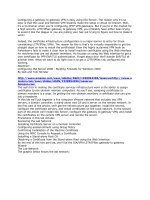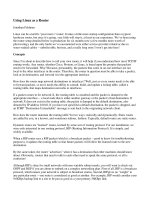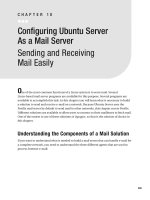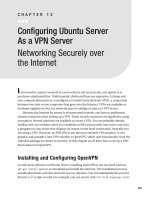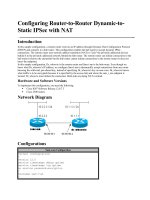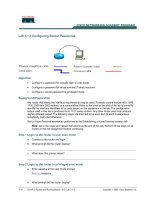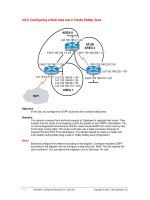Configuring a Router
Bạn đang xem bản rút gọn của tài liệu. Xem và tải ngay bản đầy đủ của tài liệu tại đây (4.94 MB, 16 trang )
PART III
Configuring a Router
Chapter 6 Configuring a Single Cisco Router
This page intentionally left blank
CHAPTER 6
Configuring a Single
Cisco Router
This chapter provides information and commands concerning the following topics:
• Router modes
• Entering global configuration mode
• Configuring a router, specifically
— Names
— Passwords
— Password encryption
— Interface names
— Moving between interfaces
— Configuring a serial interface
— Configuring a Fast Ethernet interface
— Creating a message-of-the-day (MOTD) banner
— Creating a login banner
— Setting the clock time zone
— Assigning a local host name to an IP address
— The no ip domain-lookup command
— The logging synchronous command
— The exec-timeout command
— Saving configurations
— Erasing configurations
• show commands to verify the router configurations
• EXEC commands in configuration mode: the do command
Router Modes
Router>
User mode
Router#
Privileged mode (also known as EXEC-level mode)
Router(config)#
Global configuration mode
Router(config-if)#
Interface mode
54 Configuring Passwords
TIP: There are other modes than these. Not all commands work in all modes. Be
careful. If you type in a command that you know is correct—show running-config,
for example—and you get an error, make sure that you are in the correct mode.
Entering Global Configuration Mode
Configuring a Router Name
This command works on both routers and switches.
Configuring Passwords
These commands work on both routers and switches.
Router(config-subif)#
Subinterface mode
Router(config-line)#
Line mode
Router(config-router)#
Router configuration mode
Router>
Limited viewing of configuration.
You cannot make changes in this
mode.
Router#
You can see the configuration and
move to make changes.
Router#cc
cc
oo
oo
nn
nn
ff
ff
ii
ii
gg
gg
uu
uu
rr
rr
ee
ee
tt
tt
ee
ee
rr
rr
mm
mm
ii
ii
nn
nn
aa
aa
ll
ll
Router(config)#
Moves to global configuration mode.
This prompt indicates that you can
start making changes.
Router(config)#hh
hh
oo
oo
ss
ss
tt
tt
nn
nn
aa
aa
mm
mm
ee
ee
CC
CC
ii
ii
ss
ss
cc
cc
oo
oo
The name can be any word you
choose.
Cisco(config)#
Router(config)#
ee
ee
nn
nn
aa
aa
bb
bb
ll
ll
ee
ee
pp
pp
aa
aa
ss
ss
ss
ss
ww
ww
oo
oo
rr
rr
dd
dd
cc
cc
ii
ii
ss
ss
cc
cc
oo
oo
Sets enable password
Router(config)#ee
ee
nn
nn
aa
aa
bb
bb
ll
ll
ee
ee
ss
ss
ee
ee
cc
cc
rr
rr
ee
ee
tt
tt
cc
cc
ll
ll
aa
aa
ss
ss
ss
ss
Sets enable secret password
Password Encryption 55
CAUTION: The enable secret password is encrypted by default. The enable
password is not. For this reason, recommended practice is that you never use the
enable password command. Use only the enable secret password command in a
router or switch configuration.
You cannot set both enable secret password and enable password to the same
password. Doing so defeats the use of encryption.
Password Encryption
Router(config)#ll
ll
ii
ii
nn
nn
ee
ee
cc
cc
oo
oo
nn
nn
ss
ss
oo
oo
ll
ll
ee
ee
00
00
Enters console line mode
Router(config-line)#pp
pp
aa
aa
ss
ss
ss
ss
ww
ww
oo
oo
rr
rr
dd
dd
cc
cc
oo
oo
nn
nn
ss
ss
oo
oo
ll
ll
ee
ee
Sets console line mode password to
console
Router(config-line)#ll
ll
oo
oo
gg
gg
ii
ii
nn
nn
Enables password checking at login
Router(config)#ll
ll
ii
ii
nn
nn
ee
ee
vv
vv
tt
tt
yy
yy
00
00
44
44
Enters vty line mode for all five vty
lines
Router(config-line)#pp
pp
aa
aa
ss
ss
ss
ss
ww
ww
oo
oo
rr
rr
dd
dd
tt
tt
ee
ee
ll
ll
nn
nn
ee
ee
tt
tt
Sets vty password to telnet
Router(config-line)#ll
ll
oo
oo
gg
gg
ii
ii
nn
nn
Enables password checking at login
Router(config)#ll
ll
ii
ii
nn
nn
ee
ee
aa
aa
uu
uu
xx
xx
00
00
Enters auxiliary line mode
Router(config-line)#pp
pp
aa
aa
ss
ss
ss
ss
ww
ww
oo
oo
rr
rr
dd
dd
bb
bb
aa
aa
cc
cc
kk
kk
dd
dd
oo
oo
oo
oo
rr
rr
Sets auxiliary line mode password to
backdoor
Router(config-line)#ll
ll
oo
oo
gg
gg
ii
ii
nn
nn
Enables password checking at login
Router(config)#ss
ss
ee
ee
rr
rr
vv
vv
ii
ii
cc
cc
ee
ee
pp
pp
aa
aa
ss
ss
ss
ss
ww
ww
oo
oo
rr
rr
dd
dd
--
--
ee
ee
nn
nn
cc
cc
rr
rr
yy
yy
pp
pp
tt
tt
ii
ii
o
o
oo
nn
nn
Applies a weak encryption to
passwords
Router(config)#ee
ee
nn
nn
aa
aa
bb
bb
ll
ll
ee
ee
pp
pp
aa
aa
ss
ss
ss
ss
ww
ww
oo
oo
rr
rr
dd
dd
cc
cc
ii
ii
ss
ss
cc
cc
oo
oo
Sets enable password to cisco
Router(config)#ll
ll
ii
ii
nn
nn
ee
ee
cc
cc
oo
oo
nn
nn
ss
ss
oo
oo
ll
ll
ee
ee
00
00
Moves to console line mode
Router(config-line)#pp
pp
aa
aa
ss
ss
ss
ss
ww
ww
oo
oo
rr
rr
dd
dd
CC
CC
ii
ii
ss
ss
cc
cc
oo
oo
Continue setting passwords as above
. . .
Router(config)#nn
nn
oo
oo
ss
ss
ee
ee
rr
rr
vv
vv
ii
ii
cc
cc
ee
ee
pp
pp
aa
aa
ss
ss
ss
ss
ww
ww
oo
oo
rr
rr
dd
dd
--
--
ee
ee
nn
nn
cc
cc
rr
rr
yy
yy
p
p
pp
tt
tt
ii
ii
oo
oo
nn
nn
Turns off password encryption
56 Interface Names
CAUTION: If you have turned on service password encryption, used it, and then
turned it off, any passwords that you have encrypted will stay encrypted. New
passwords will remain unencrypted.
Interface Names
One of the biggest problems that new administrators face is the interface names on the
different models of routers. With all the different Cisco devices in production networks
today, some administrators are becoming confused about the names of their interfaces.
The following chart is a sample of some of the different interface names for various routers.
This is by no means a complete list. Refer to the hardware guide of the specific router
that you are working on to see the different combinations, or use the following command
to see which interfaces are installed on your particular router:
router#ss
ss
hh
hh
oo
oo
ww
ww
ii
ii
pp
pp
ii
ii
nn
nn
tt
tt
ee
ee
rr
rr
ff
ff
aa
aa
cc
cc
ee
ee
bb
bb
rr
rr
ii
ii
ee
ee
ff
ff
Router
Model
Port
Location/Slot
Number Slot/Port Type
Slot Numbering
Range Example
2501 On board Ethernet Interface-type number ethernet0 (e0)
On board Serial Interface-type number serial0 (s0) &
s1
2514 On board Ethernet Interface-type number e0 & e1
On board Serial Interface-type number s0 & s1
1721 On board Fast Ethernet Interface-type number fastethernet0
(fa0)
Slot 0 WAC (WIN
interface card)
(serial)
Interface-type number s0 & s1
1760 On Board Fast Ethernet Interface-type 0/port fa0/0
Slot 0 WIC/VIC (voice
interface card)
Interface-type 0/port s0/0 & s0/1
v0/0 & v0/1
Slot 1 WIC/VIC Interface-type 1/port s1/0 & s1/1
v1/0 & v1/1


